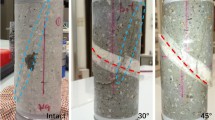Summary
The conditions for sliding over artificial joint surfaces have been studied experimentally by cutting rock cylinders at various angles to their axes and studying slip over these surfaces in a triaxial testing apparatus. The types of joint used were: (i) filled with plaster to simulate a soft joint filling, (ii) bare surfaces ground approximately flat, and (iii) natural surfaces across which shear failure had taken place. The results agreed reasonably well with the simple theory for a constant coefficient of friction. Measured coefficients of friction lie in the range 0.5–0.8 and differ by surprisingly little between the various surfaces. The surfaces across which sliding has taken place exhibit interesting slickenside phenomena. Subsidiary failures frequently occur which cut across the joint surfaces.
Similar content being viewed by others
References
Talobre J.:La mécanique des roches. Dunod, Paris (1957).
Paterson M. S.:Experimental deformation and faulting in Wombeyan marble. Bull. Geol. Soc. America. Vol. 69, p. 465 (1957).
Jaeger J. C.:Elasticity, Fracture and Flow. Methuen (1958).
Author information
Authors and Affiliations
Rights and permissions
About this article
Cite this article
Jaeger, J.C. The frictional properties of joints in rock. Geofisica Pura e Applicata 43, 148–158 (1959). https://doi.org/10.1007/BF01993552
Received:
Issue Date:
DOI: https://doi.org/10.1007/BF01993552



